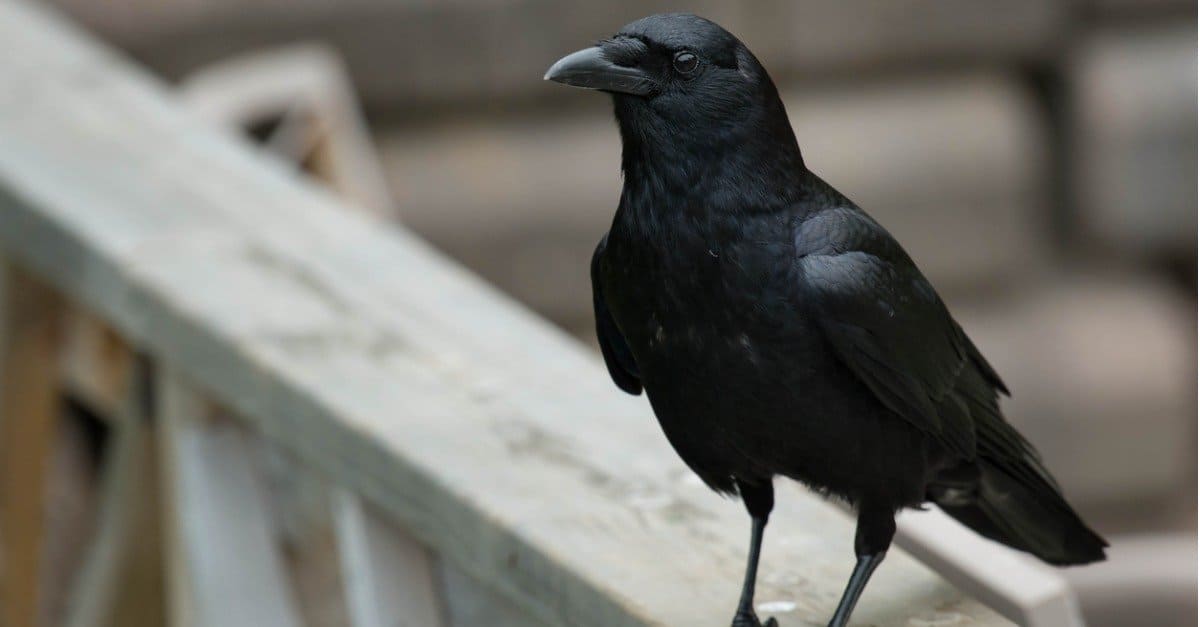Birds have so many different types of names, and only a few have common names that start with the letter A. In this article, we’ll take a look at some birds that start with A that are incredible in their own right. We’ll also look at some birds that start with A that are the biggest and strongest in their letter category. Common birds that start with the letter A include American robin, acorn woodpecker, American crow, Ashy storm-petrel, American kestrel, American goldfinch, alder flycatcher, Anna’s hummingbird, American avocet, Atlantic puffin, Andean condor, and African grey hornbill. Read on to learn more about these amazing birds. Let’s dive in!
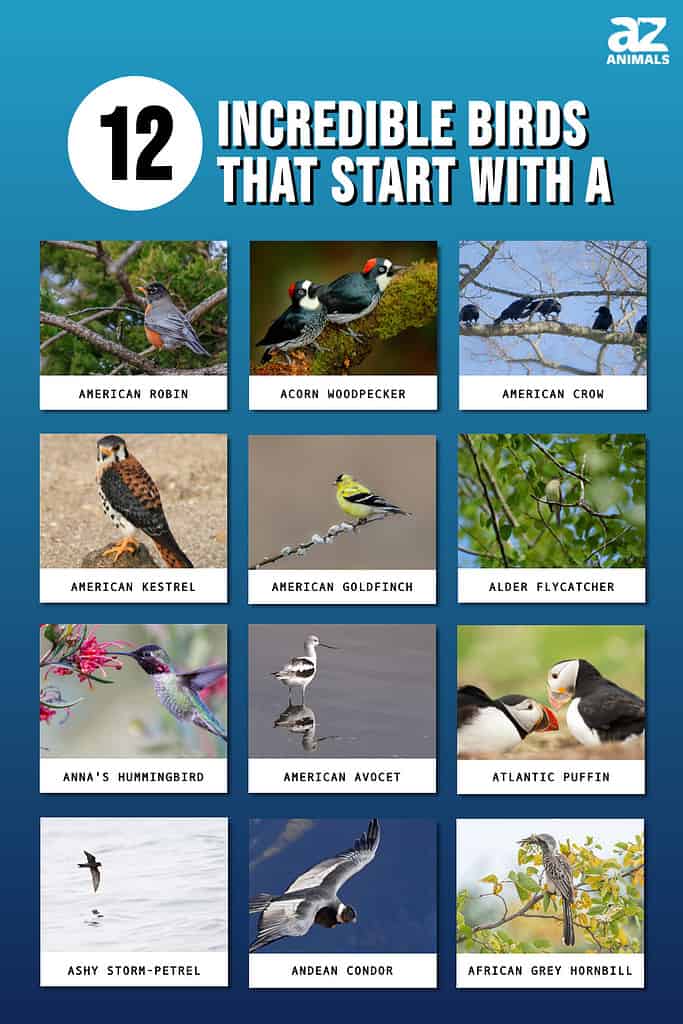
1. American Robin
Classification: Turdus migratorius
The American Robin is a well-known and adored North American bird species. It is a medium-sized thrush with a distinguishing white eye ring, grayish-brown upper parts, and reddish-orange breast. In parks, gardens, forests, and suburban areas all around the continent, you can regularly find American robins.
The approach of spring is frequently connected with the melodic singing of these birds. They eat a variety of foods, such as berries, fruits, insects, and earthworms. The American Robin is renowned for its capacity for visual feeding and frequently employs a recognizable “head cock” action to detect food.
The American Robin constructs cup-shaped nests out of twigs, grass, and mud during the mating season, generally in trees or bushes. For the course of the mating season, they establish pairs and are usually monogamous.
The migratory patterns of American Robins are one of their most distinctive behaviors. Numerous robin populations make long-distance migrations, with some birds going as far north as Alaska or Canada in the summer before heading south to the United States or Mexico in the winter.

The American Robin (pictured) is native to North America.
©Richard G Smith/Shutterstock.com
2. Acorn Woodpecker
Classification: Melanerpes formicivorus
The intriguing Acorn Woodpecker is native to Western North America, from the southwest of the United States to portions of Mexico. The peculiar behavior and remarkable look of this woodpecker are what make it so interesting.
The distinctive “granary trees” of the Acorn Woodpecker are one of its distinguishing characteristics. By boring holes into tree trunks and utilizing telephone poles or dead trees, these birds construct communal storage facilities. They then load acorns and other nuts into these holes to serve as the group’s core food source. They differ from other woodpecker species because of their cooperative nature, as most woodpeckers are solitary creatures.
The remarkable plumage of acorn woodpeckers includes a black head, a white forehead, and a brilliant red crown. When they fly, their black and white wings have striking patterns. Being sociable creatures, they dwell in big family units made up of several adult males, females, and young birds. They use a variety of different cries and drumming noises to communicate.
The Acorn Woodpecker is mostly found in mixed coniferous and oak woods, where oak trees serve as a major source of food. They have powerful bills that are ideally suited for digging holes and clinging to tree trunks.

The Acorn Woodpecker (pictured) is native to western North America.
©Ondrej Prosicky/Shutterstock.com
3. American Crow
Classification: Corvus brachyrhynchos
The North American continent is home to several different populations of the American Crow, a highly adaptable and clever bird species. The American Crow, which is well-known for its glossy black plumage, robust bulk, and characteristic cawing cries, is a common sight in urban, suburban, and rural settings.
The varied diet of American Crows includes insects, small animals, fruits, seeds, carrion, and even leftover human meals. They are opportunistic omnivores. They can flourish in a variety of settings, including woods, open fields, parks, and residential areas.
The American Crow is unique due to its high level of intellect and capacity for problem-solving. They have been seen making use of tools, exhibiting sophisticated social activities, and even identifying certain human faces. The complex vocalizations of crows, which include a variety of calls and vocal mimicry, are also well-known.
During the times when they are not mating, these birds often create enormous communal roosts where hundreds of crows congregate for social interaction and protection. The adaptability, intelligence, and gregarious character of the American Crow make it a fascinating and charismatic bird that is important to many ecosystems across North America.

The American Crow (pictured) is native to North America.
©iStock.com/Karel Bock
4. American Kestrel
Classification: Falco sparverius
The small and vibrant American Kestrel is a type of falcon that may be found all throughout North and South America. It is the smallest falcon found in North America and is renowned for both its eye-catching plumage and exceptional hunting abilities.
American Kestrels frequently inhabit open environments including grasslands, meadows, fields of crops, and deserts. They can even adapt to urban settings and can be seen hunting in city parks or perched on telephone lines. The capacity of these birds to hover in midair while hunting for prey is one of their most interesting characteristics.
The American Kestrel is distinguished for its colorful plumage. Males have striking slate-blue heads with a white and black facial pattern, along with blue-gray wings and a reddish-brown back. The color pattern in females is comparable, but they have more brown tones. They are very easy to recognize in flight thanks to their vibrant appearance.
The hunting habits of the American Kestrel are another distinctive feature. They mostly eat insects, birds, and small animals. These birds have exceptional vision and can locate prey at a great distance. They quickly dive and snag their prey with their razor-sharp talons after spotting it.
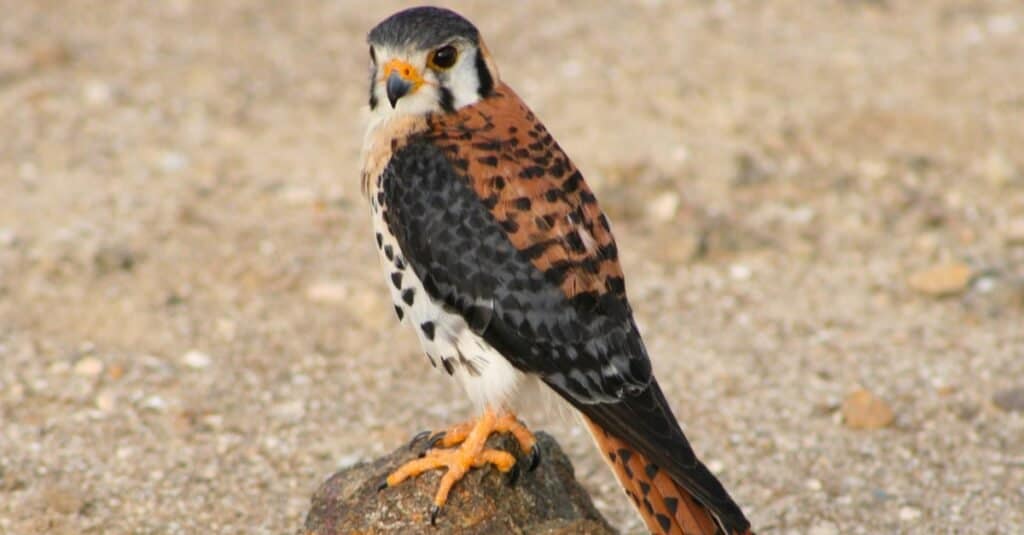
The American Kestrel (pictured) is native to North and South America.
©Megan M. Weber/Shutterstock.com
5. American Goldfinch
Classification: Spinus tristis
Native to North America, the American Goldfinch is a small and colorful songbird. The American Goldfinch is a beautiful sight in gardens, meadows, and open forests all throughout the continent. It is distinguished by its bright yellow plumage and upbeat singing.
Fields, grasslands, and weedy regions are the main environments where these birds may be found. Given that the majority of their food consists of seeds, including thistle seeds, sunflower seeds, and other tiny seeds, they are usually drawn to regions with a lot of thistle plants. In order to feed their offspring throughout the mating season, they also consume insects.
The seasonal fluctuation in the American Goldfinch’s plumage is one of its most distinctive traits. Males have brilliant yellow feathers with striking black wings and caps throughout the mating season in late spring and summer. Both males and females change to a more muted olive-brown coloration in the winter. This modification of their plumage improves their ability to conceal themselves and fit in with their environment.
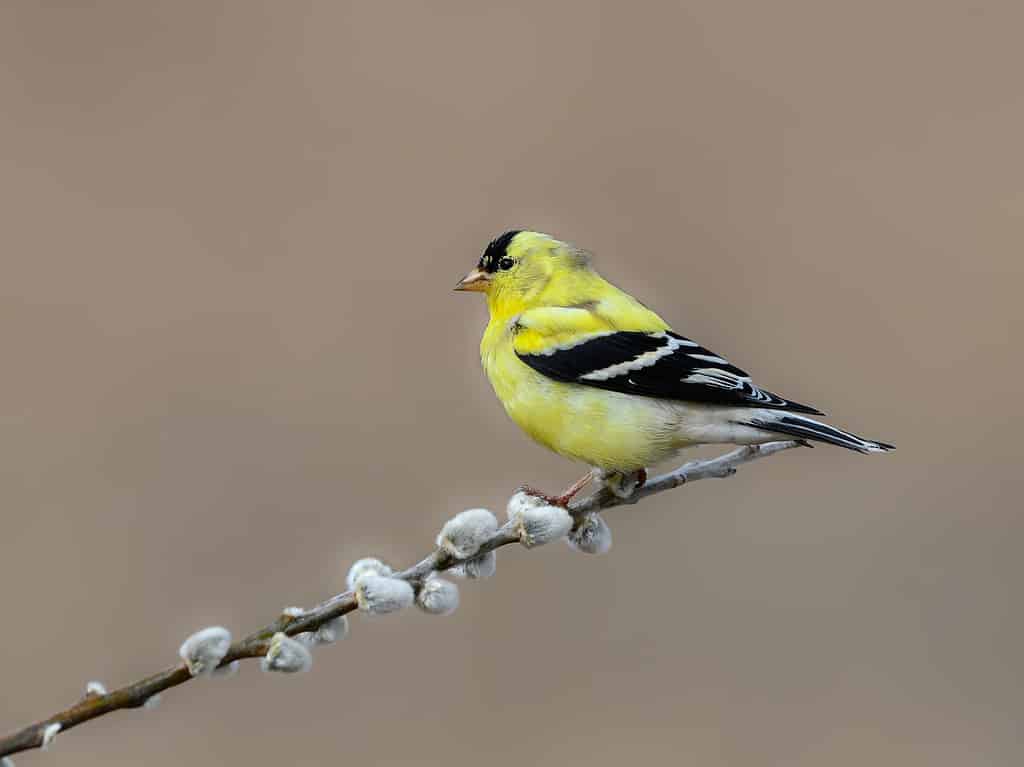
The American Goldfinch (pictured) is native to the North American continent.
©FotoRequest/Shutterstock.com
6. Alder Flycatcher
Classification: Empidonax alnorum
The small migratory bird species known as the Alder Flycatcher are predominantly found in North America. It breeds in environments that are damp and swampy, especially in places where there are alder groves, willow swamps, and other dense vegetation. They migrate to Central and South America throughout the winter.
The upper parts of Alder Flycatchers have a greenish-brown tint, while their neck and underparts are a pale yellowish color. They have different vocalizations that are frequently used to identify them.
As suggested by their name, they favor wetlands with dense flora and alder trees as habitats. They collect an abundance of insects on the flight in these settings. Alder Flycatchers can be difficult to spot because of their modest size and rather covert behavior.

The Alder Flycatcher (pictured) is native to North, Central, and South America.
©James W. Thompson/Shutterstock.com
7. Anna’s Hummingbird
Classification: Calypte anna
We can’t forget Anna’s Hummingbird when talking about birds that start with A! The Anna’s Hummingbird is a small but fascinating bird species that may be found in areas of Baja California and California’s western coast. This species of hummingbird, named after Anna Masséna, Duchess of Rivoli, stands out due to its distinctive traits.
The environments that Anna’s Hummingbirds call home include coastal scrublands, gardens, parks, and forests. They usually visit backyard feeders or nectar-rich blooms and are well-known for adapting to urban areas.
The magnificent iridescent plumage that male Anna’s Hummingbirds show is one amazing characteristic of the species. Their belly and wings display hues of green and gray, while their crowns and throats sparkle in vivid hues of iridescent red and pink. Although less colorful, females have lovely green and gray feathers that aid with blending into their environment.
This species’ year-round mating habits, which are unusual for hummingbirds in North America, are another distinguishing feature. They create elaborate nests in the form of cups and frequently attach them to branches using materials like spider silk. There are also complex courting displays performed by male Anna’s Hummingbirds, which include airborne maneuvres and quick dives.
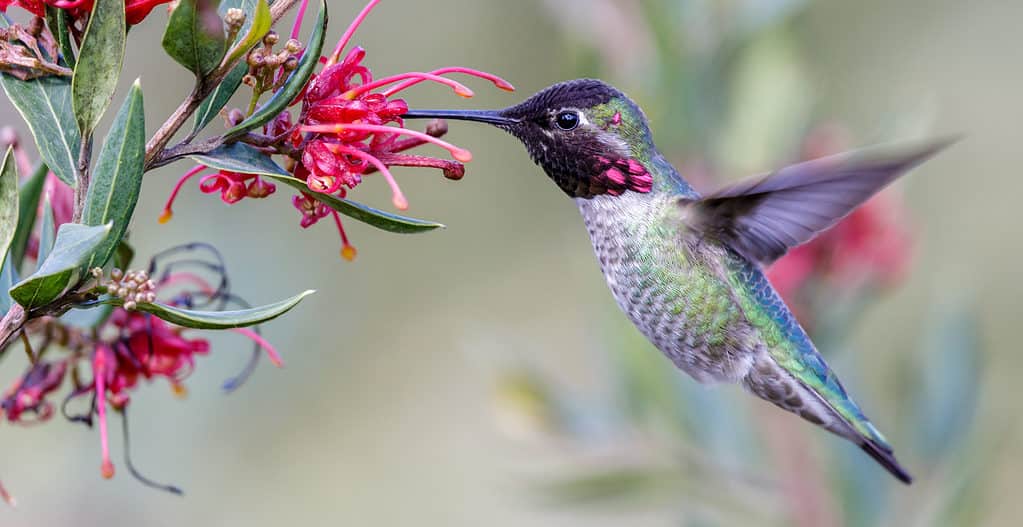
Anna’s Hummingbird (pictured) is native to the Californian coast of the United States.
©yhelfman/Shutterstock.com
8. American Avocet
Classification: Recurvirostra americana
The American Avocet is a graceful and unique bird species that may be found in a variety of locations all around North America. Its stunning black-and-white plumage and long, upward-curving black beak are well known for making it easy to identify.
Salt flats, mudflats, marshes, and the shorelines of alkaline or saline lakes are among the shallow wetlands where American Avocets can be found. They may be found in various areas of Canada and Mexico and are particularly common in the western sections of the United States.
The American Avocet’s eating habits are one of its distinctive characteristics. They sweep back and forth across the water with their long, narrow bills, catching tiny aquatic invertebrates and insects. The way they feed is known as “scything,” and it distinguishes them from other bird species.
The American Avocet puts on amazing wooing displays during its breeding season. To entice females, males engage in complex dances that include head bobbing, wing flapping, and bill circling. They construct small scrapes on the ground covered with plant material to create their colonies’ nests, which are usually on islands or elevated locations inside wetlands.
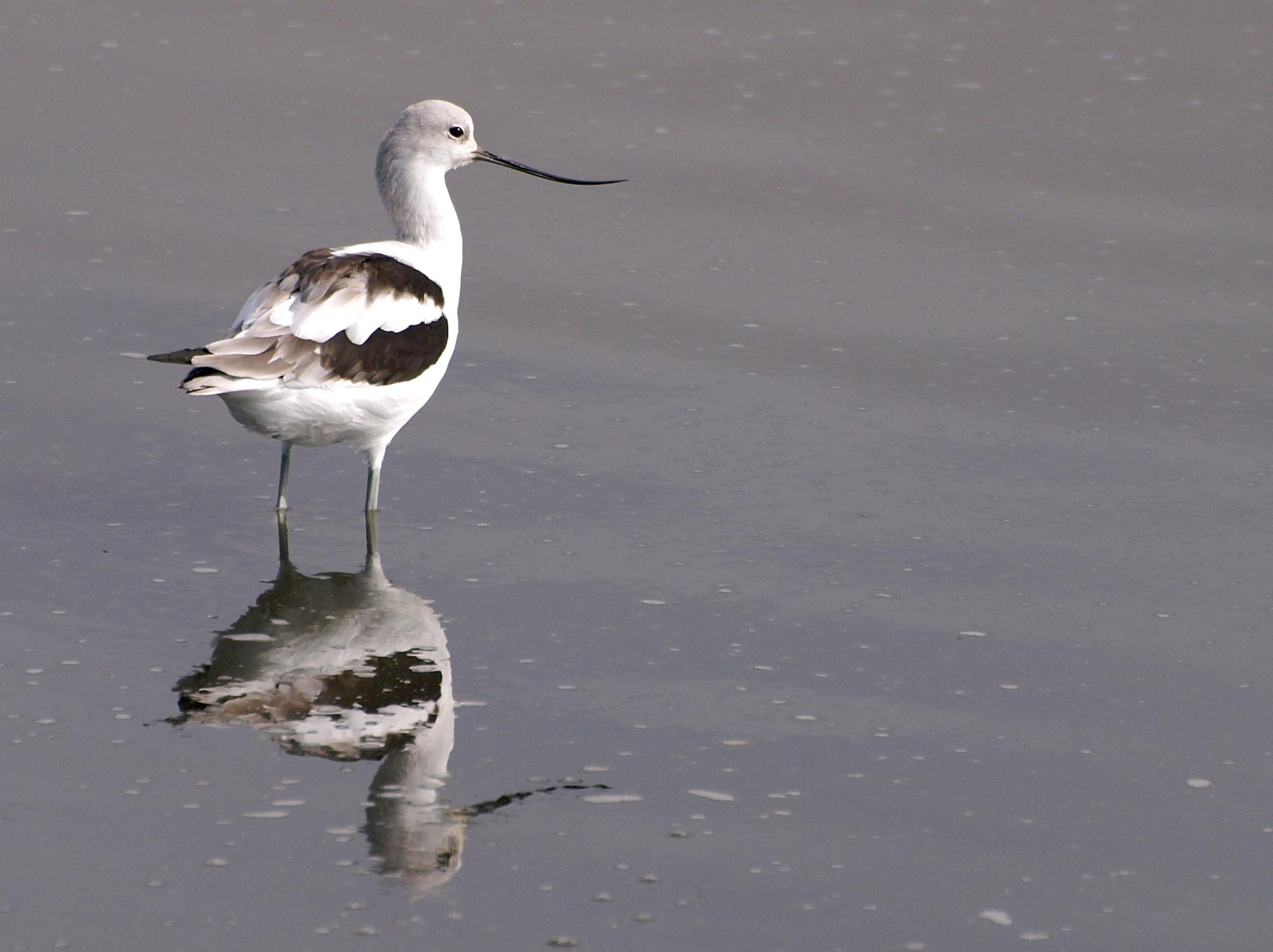
The American Avocet (pictured) can be found in Canada, the U.S., and Mexico.
©Ingrid Taylar from San Francisco Bay Area – California, USA, CC BY 2.0, via Wikimedia Commons – Original / License
9. Atlantic Puffin
Classification: Fratercula arctica
The charming and endearing Atlantic Puffin is a type of seabird distinguished by its colorful beak and unusual look. It can be found in coastal areas of the northern United States, Canada, Greenland, Iceland, and portions of Europe. It is mostly found in the North Atlantic Ocean.
The majority of an Atlantic Puffin’s life is spent at sea, and they only land to reproduce. On outlying islands and coastal cliffs, they build colonies to nest. These birds build their nests by digging tunnels or by using rocky niches.
The bright beak of the Atlantic Puffin is what truly sets it apart. Their beaks become a vivid, multicolored display with hues of orange, yellow, and blue during the mating season. This distinctive beak is crucial for distinguishing different birds and for courting displays.
These birds are very superb divers and can quickly dive into water to grab fish and marine invertebrates. They are skilled hunters in their marine home thanks to their extraordinary underwater agility and ability to swim and “fly” underwater simultaneously.
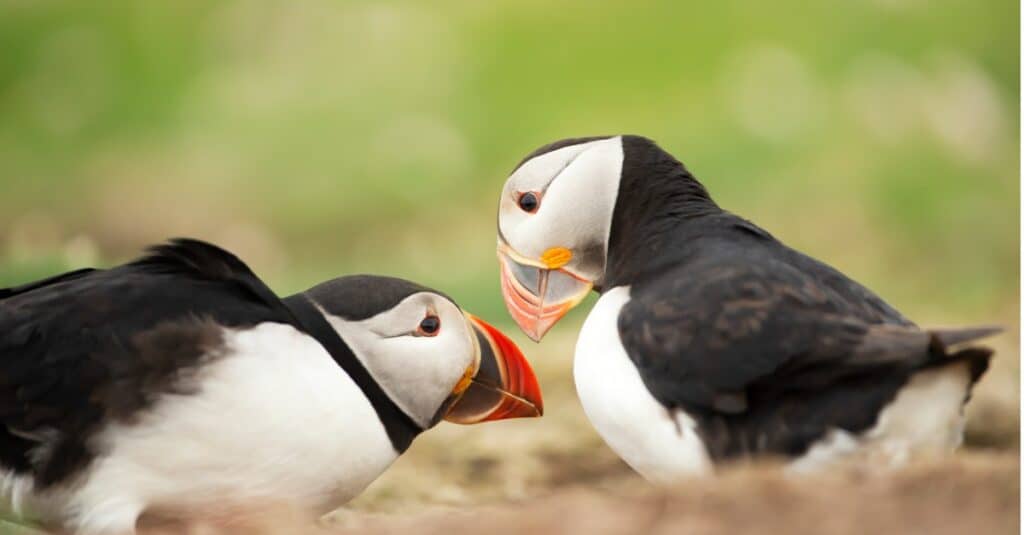
The Atlantic Puffin (pictured) can be found in the North Atlantic Ocean.
©Giedriius/Shutterstock.com
10. Ashy Storm-Petrel
Classification: Oceanodroma homochroa
These small seabirds are distinguished by their beautiful flight displays and dark gray plumage. The Ashy Storm-Petrel is mostly found in California and Baja California along North America’s Pacific coast.
Ashy Storm-Petrels frequent offshore and nearshore seas, often gathering close to islands and rocky shorelines. On distant islands where they seek safety from predators, they lay their eggs in cracks or burrows.
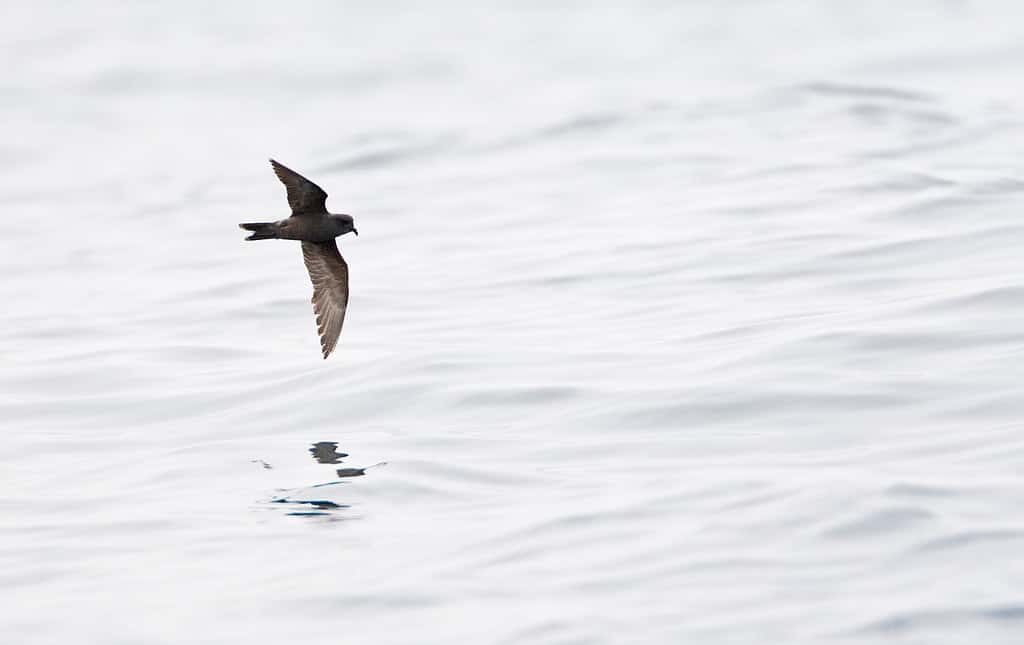
The Ashy Storm-Petrel (pictured) is native to the Pacific Coast of North America.
©Agami Photo Agency/Shutterstock.com
The Ashy Storm-Petrel is distinct due to its nocturnal habits. These birds are most active at night, which is when they hunt for tiny fish and krill in murky waters using their strong hearing and smell senses. They differ from diurnal seabirds in that they can hunt and travel in low light.
These birds fly in a fluttering manner with quick wingbeats and sporadic glides. They frequently skim the water’s surface, plucking food from the water with their pointed beaks.
It has been historically difficult to study and observe Ashy Storm-Petrels because of their isolated nesting grounds and nocturnal behavior. However, they are a fascinating and much sought-after seabird species throughout the Pacific coast due to their unique behavior, dark plumage, and particular adaptations to the maritime environment.
The Largest Bird That Starts A
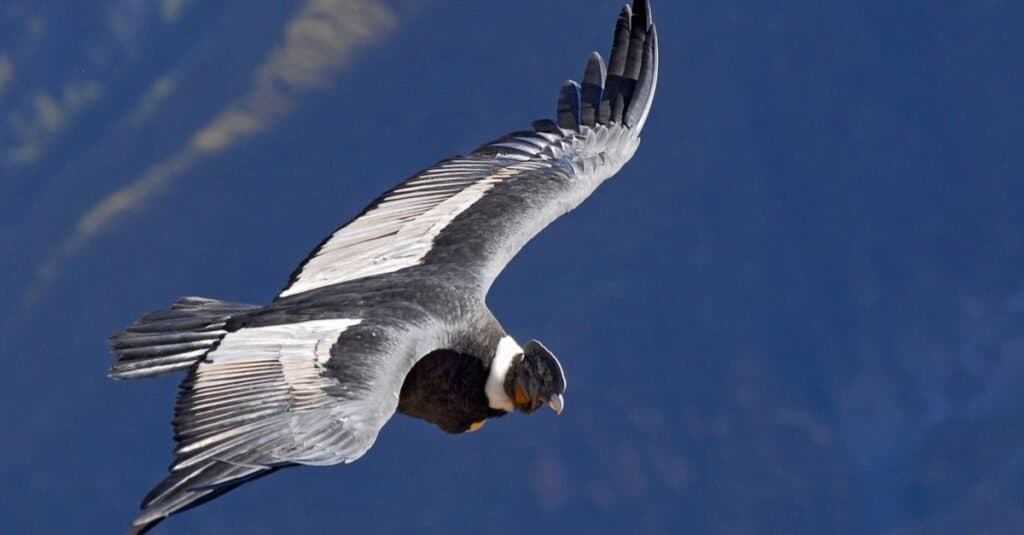
The Andean condor is Colombia’s national bird.
©Cezary Wojtkowski/Shutterstock.com
The largest living bird species that starts with the letter A is the Andean Condor or Vultur gryphus. One of the largest flying birds in the world, the Andean Condor is a majestic bird of prey. It is mostly located in the high-altitude areas of South America’s Andes Mountains, which includes nations like Peru, Argentina, Ecuador, and Chile.
The wild and mountainous habitat of Andean condors includes cliffs, valleys, and wide grasslands. They choose locations with strong updrafts that enable effortless flight and thermal currents for gaining height and covering great distances.
The Andean Condor is quite amazing in terms of size. They have one of the largest wingspans of any bird species at almost 10 feet. These birds weigh up to 33 pounds on average and have a huge, strong frame. They can explore large areas in search of carrion, which is their main source of food, because of their size and ability to fly.
The Fastest Bird that Starts with A
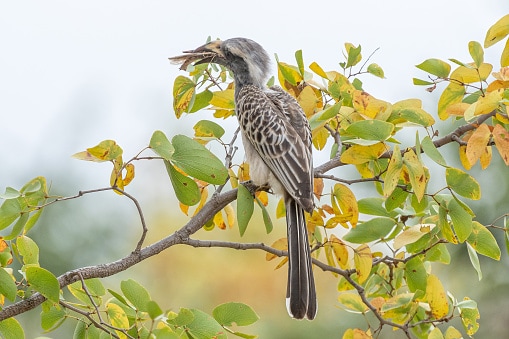
African Grey Hornbill is the fastest bird species that starts with the letter A.
©GroblerduPreez/ via Getty Images
The fastest-living bird species that starts with the letter A is the African Grey Hornbill or Tockus nasutus. The African Grey Hornbill is found in sub-Saharan Africa, especially in nations like Kenya, Tanzania, Zimbabwe, and South Africa. It lives in a variety of environments, including open scrublands, savannas, and forests.
The long, curving, and vividly colored bill of the African Grey Hornbill is one of its distinctive characteristics. The bill is employed for a number of tasks, including capturing insects, foraging for food, and even keeping females enclosed in tree hollows when they are in the nesting stage.
The African Grey Hornbill has a quick and agile flight habit. It can swiftly move through the woods and move around its environment. However, it’s crucial to remember that the African Grey Hornbill’s flight talents are more concerned with accuracy and control as it navigates its environment’s dense foliage than with speed.
Summary of 12 Incredible Birds That Start With A
| # | Bird | Classification |
|---|---|---|
| 1 | American Robin | Turdus migratorius |
| 2 | Acorn Woodpecker | Melanerpes formicivorus |
| 3 | American Crow | Corvus brachyrhynchos |
| 4 | American Kestrel | Falco sparverius |
| 5 | American Goldfinch | Spinus tristis |
| 6 | Alder Flycatcher | Empidonax alnorum |
| 7 | Anna’s Hummingbird | Calypte anna |
| 8 | American Avocet | Recurvirostra americana |
| 9 | Atlantic Puffin | Fratercula arctica |
| 10 | Ashy Storm-Petrel | Oceanodroma homochroa |
| 11 | Andean Condor | Vultur gryphus |
| 12 | African Grey Hornbill | Tockus nasutus |
Thank you for reading! Have some feedback for us? Contact the AZ Animals editorial team.

